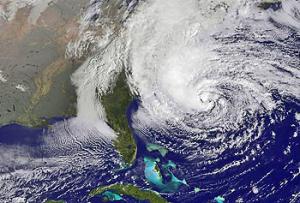Emerging threatsWarmer oceans could produce more powerful, destructive superstorms
Hurricane Sandy became the second costliest hurricane to hit the United States when it blew ashore in October 2012, killing 159 people and inflicting $71 billion in damage. Informally known as a “superstorm” after it made landfall, Sandy was so destructive largely because of its unusual size and track. After moving north from the tropical waters where it spawned, Sandy turned out to sea before hooking back west, growing in size and crashing head-on into the East Coast, gaining strength when it merged with an eastbound mid-latitude storm. A new study led by the University of Maryland’s Earth System Science Interdisciplinary Center (ESSIC) suggests that a warmer Atlantic Ocean could substantially boost the destructive power of a future superstorm like Sandy.

Hurricane Sandy striking Georgia / South Carolina // Source: Warmer oceans could produce more powerful, destructive superstorms
Hurricane Sandy became the second costliest hurricane to hit the United States when it blew ashore in October 2012, killing 159 people and inflicting $71 billion in damage. Informally known as a “superstorm” after it made landfall, Sandy was so destructive largely because of its unusual size and track. After moving north from the tropical waters where it spawned, Sandy turned out to sea before hooking back west, growing in size and crashing head-on into the East Coast, gaining strength when it merged with an eastbound mid-latitude storm.
UMD reports that a new study led by the University of Maryland’s Earth System Science Interdisciplinary Center (ESSIC) suggests that a warmer Atlantic Ocean could substantially boost the destructive power of a future superstorm like Sandy. The researchers used a numerical model to simulate the weather patterns that created Sandy, with one key difference: a much warmer sea surface temperature, as would be expected in a world with twice as much carbon dioxide in the atmosphere. This simulated warmer ocean generated storms that were 50 to 160 percent more destructive than Sandy. The results appear online 19 January 2016 in the journal Geophysical Research Letters.
“This kind of experiment is not necessarily a realistic simulation, but it is along a similar path that the future climate might expect to evolve,” said William Lau, a research scientist at ESSIC and senior scientist emeritus at NASA’s Goddard Space Flight Center. Lau added that sea surface temperatures could reach such elevated levels within the next 50 to 100 years.
In the model scenarios, the pool of warm water (greater than 82 degrees Fahrenheit) in the tropical Atlantic grew to twice its actual size. The larger warm pool gave the simulated hurricanes more time to grow before they encountered colder water or land.
In the five simulations conducted by Lau and his colleagues at NASA Goddard, two hurricanes followed the same track as Sandy, hooking westward and merging with the mid-latitude storm as they hit the coast. Because of their longer exposure to the large warm pool, their winds had 50 to 80 percent more destructive power, and they brought 30 to 50 percent more heavy rain.
“We expected the storm would definitely get stronger because of much warmer sea surface temperature,” Lau said.
